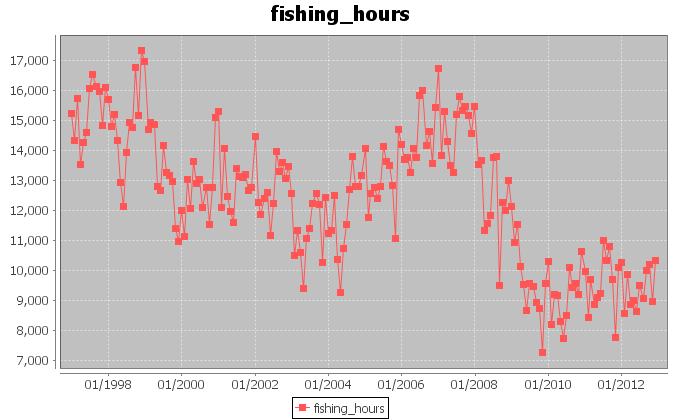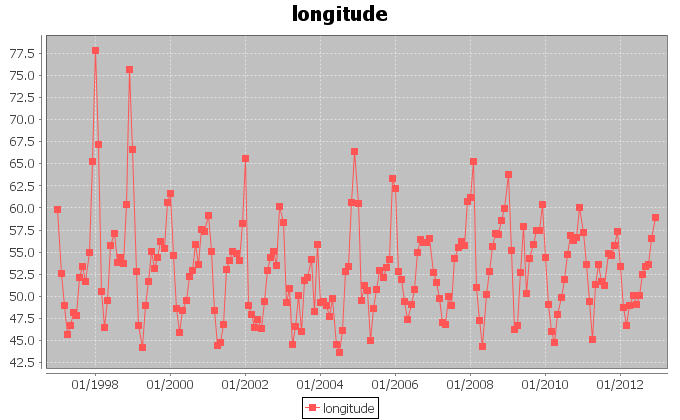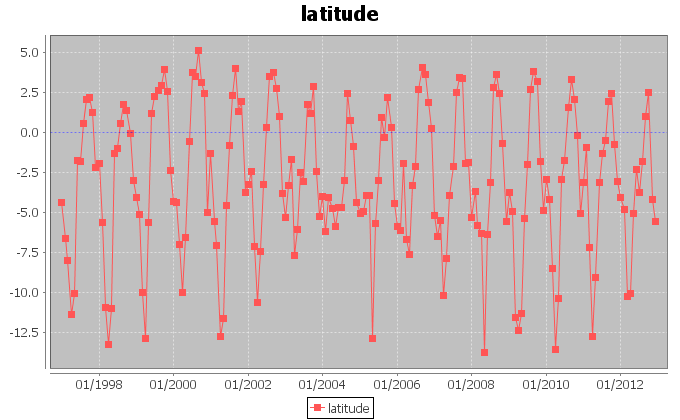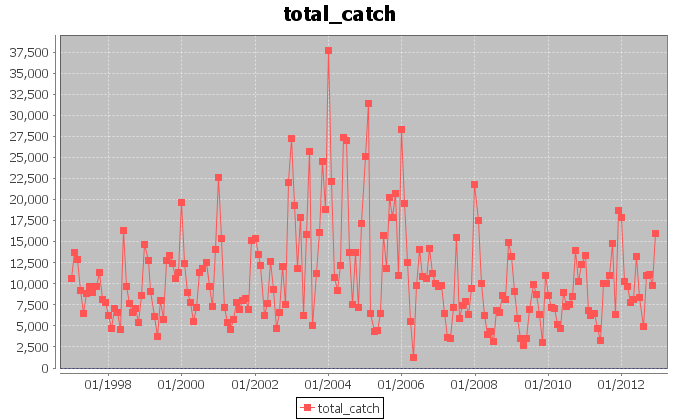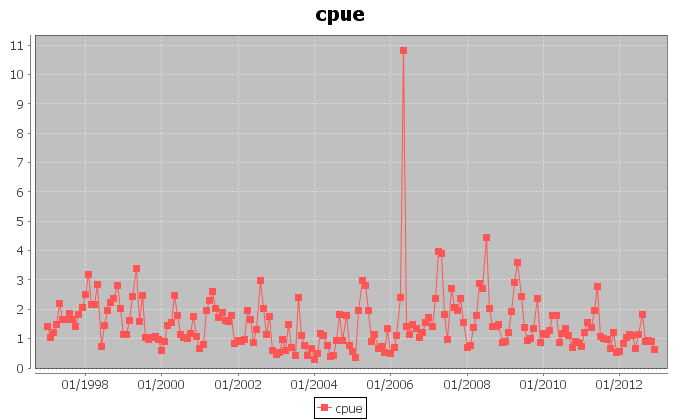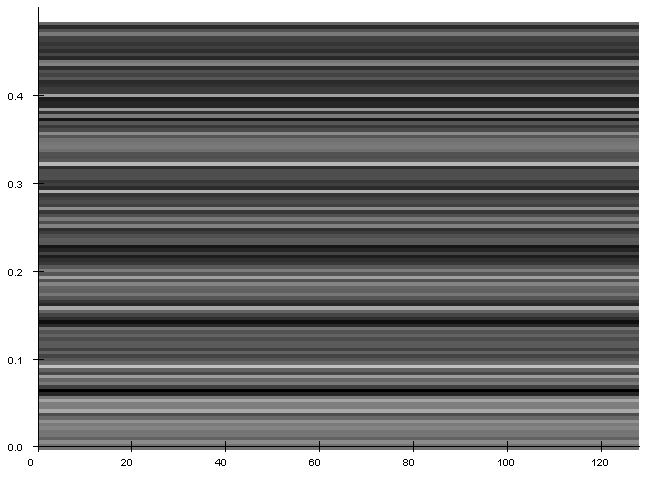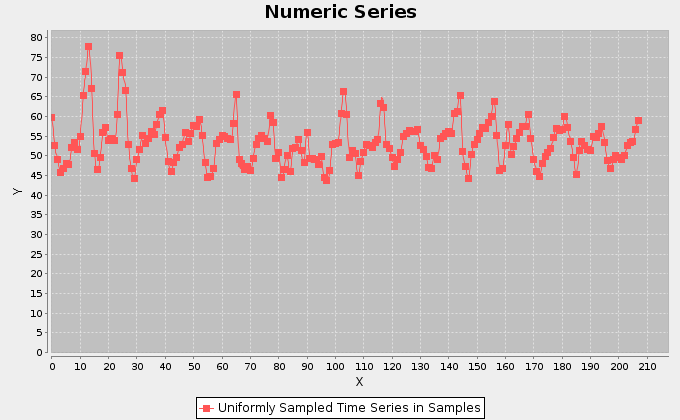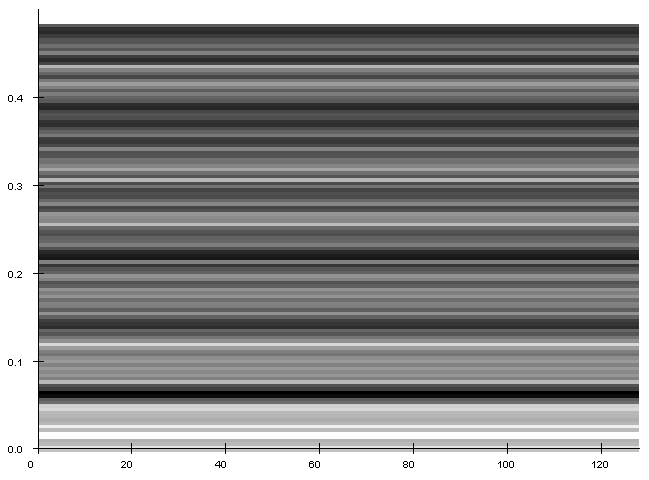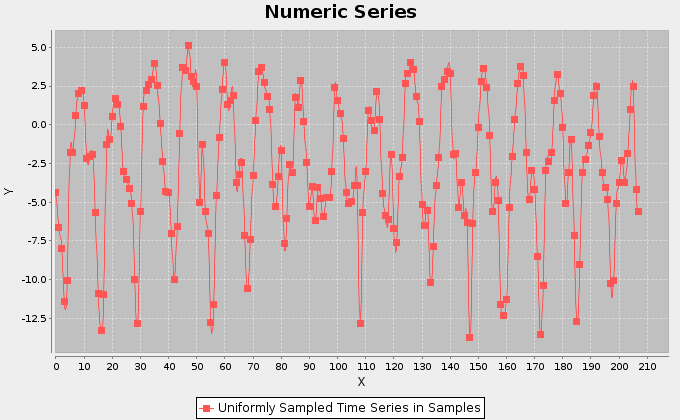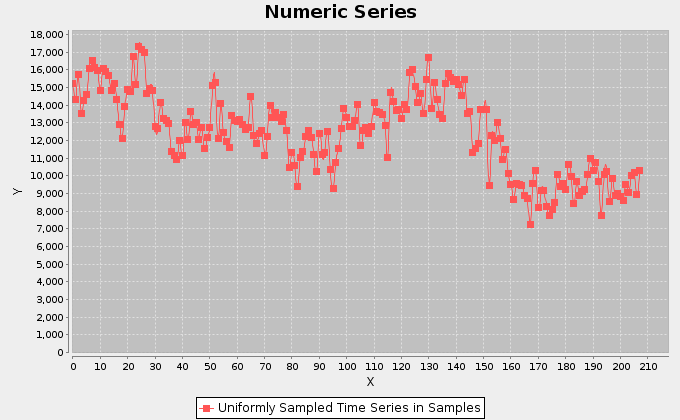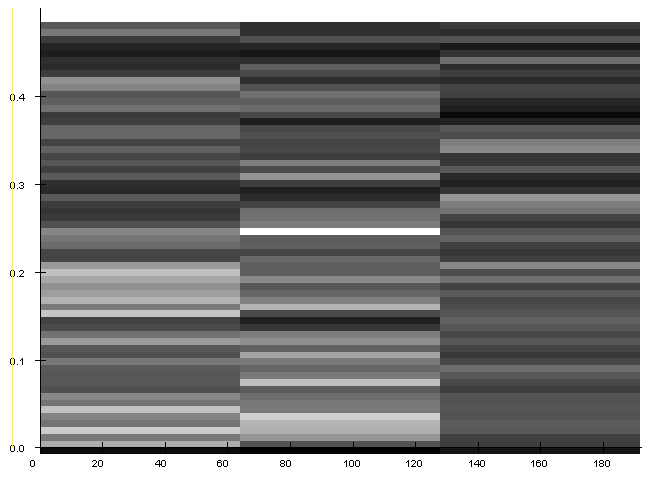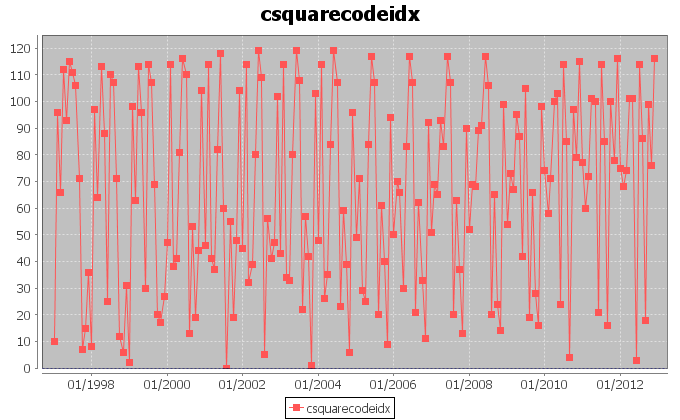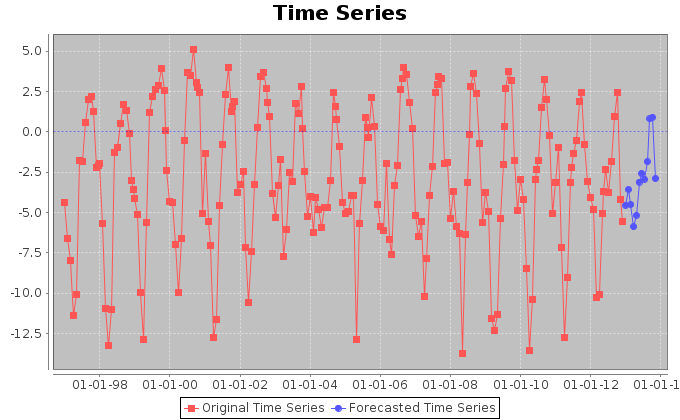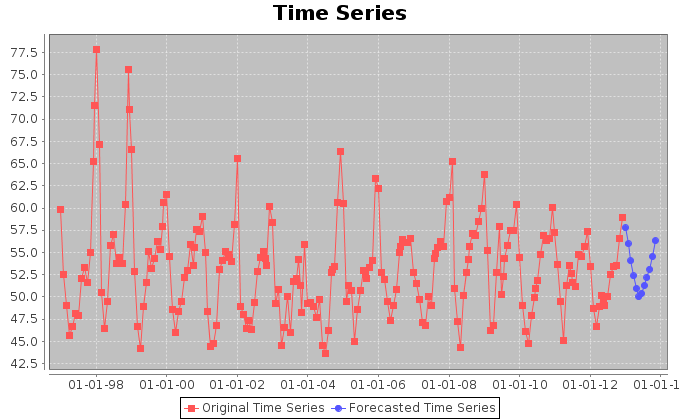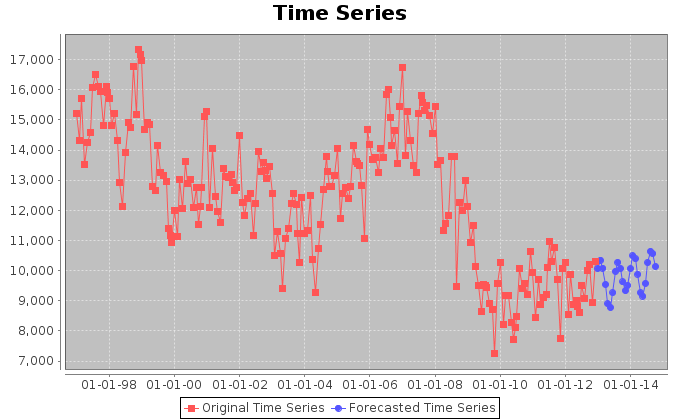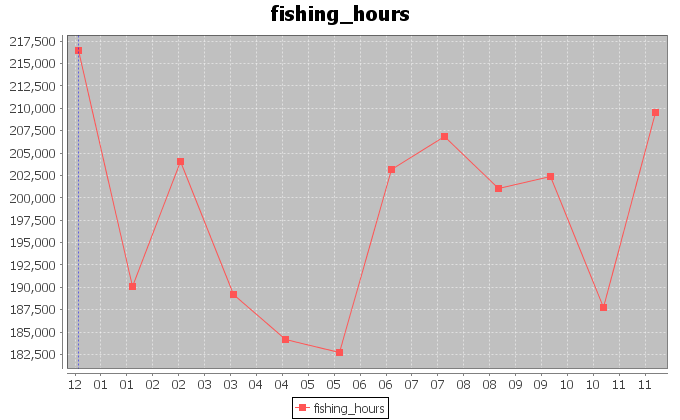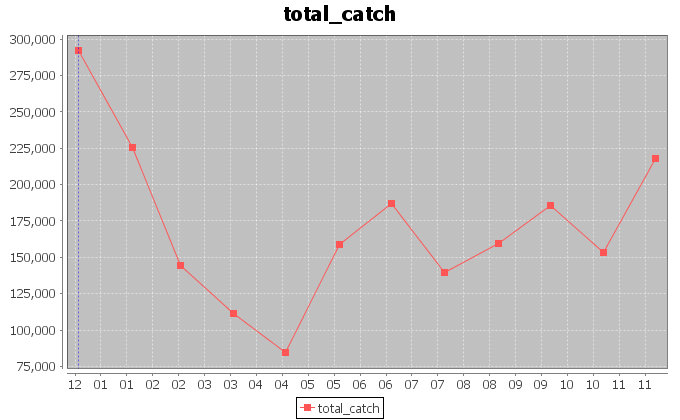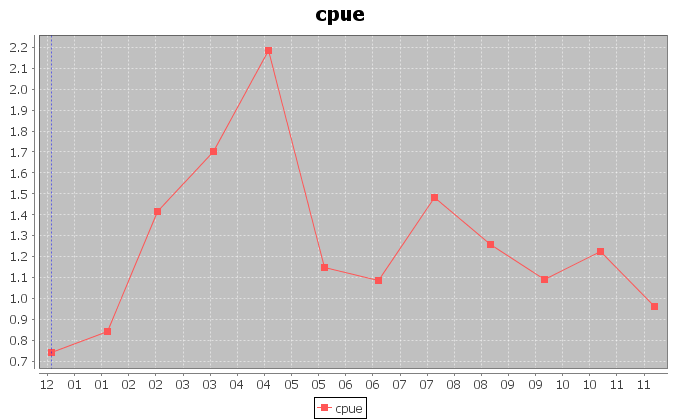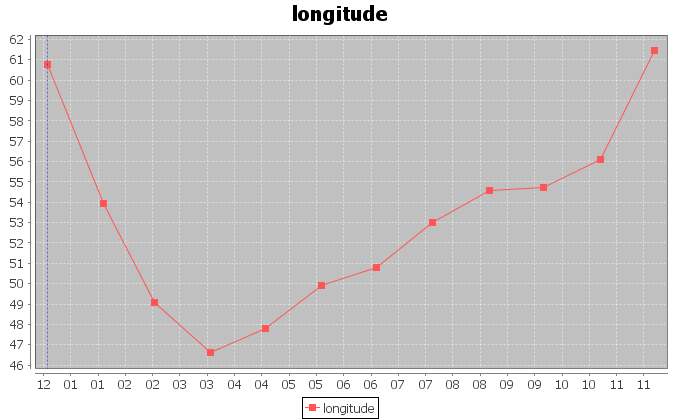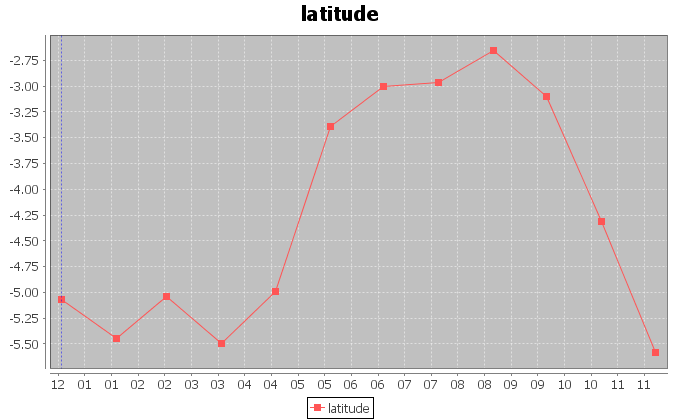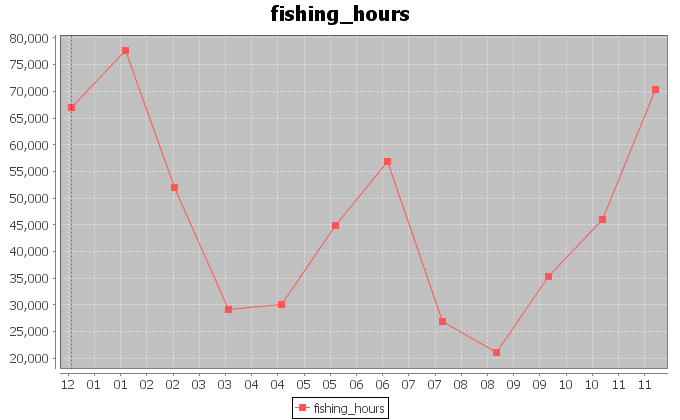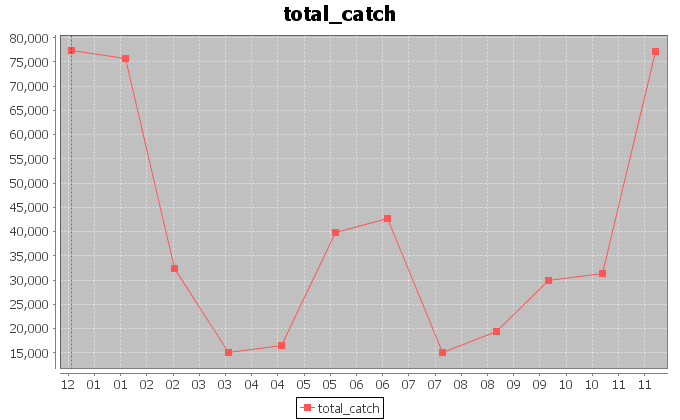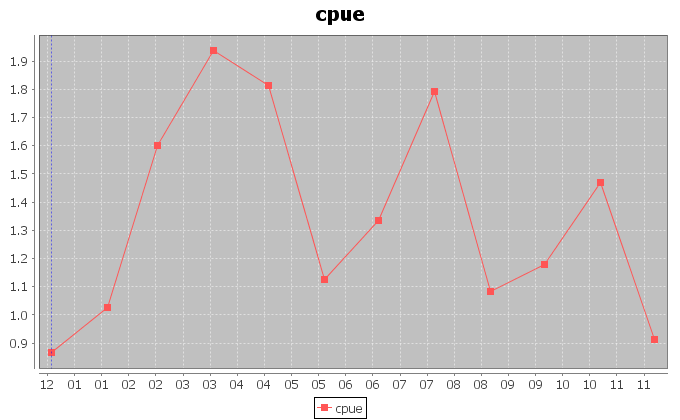Difference between revisions of "IOTC Area Predictive analysis"
(→Approach) |
|||
| (38 intermediate revisions by 3 users not shown) | |||
| Line 1: | Line 1: | ||
==Description== | ==Description== | ||
| + | The Indian Ocean Tuna Commission (IOTC) is an intergovernmental organization that coordinates the regulation and management of tuna in the Indian Ocean. The commission publishes data about fishing activity, to be used by fishery managers for monitoring catch effort and ocean exploitation. | ||
| + | |||
| + | The experiment described in this page, focuses on the '''purse seine fishing''' activity. | ||
| + | |||
| + | '''This page reports an analysis to detect, monitor and predict such activity. Its scope is also to show an example of statistical analysis methods the D4Science e-Infrastructure allows to apply to fishery data. It is meant to give a slight overview of the signal processing techniques hosted by the services in the infrastructure, rather than to produce a scientific result.''' | ||
==Hypothesis and Thesis== | ==Hypothesis and Thesis== | ||
| − | == | + | ====Premise==== |
| + | * The analysis benchmark is made up of a report about purse seine fishing activity in the Indian Ocean involving Yellowfin tuna. | ||
| − | + | ====Hypothesis==== | |
| − | + | * The tuna purse-seining fishing activities in the IOTC area are periodic and localized and can be predicted. | |
| − | + | ||
| − | + | ||
| − | + | ====Theses==== | |
| − | + | * Basic statistical analysis, trends displaying and signal processing can detect periodic properties; | |
| − | + | * Forecasting techniques can predict future exploitation. | |
| − | + | ||
| + | ==Outcome== | ||
| + | |||
| + | Starting from IOTC reports about purse seine fishing activity, in the Indian Ocean from 1997 to 2012, we detected the following phenomena: | ||
| + | |||
| + | # an overall '''periodic''', yet decreasing, '''number of Purse Seine fishing hours''' in the Indian Ocean; | ||
| + | # a '''periodic trend in the visitation of fishing locations''' by vessels, with '''periodicity around 1 year'''; | ||
| + | # an overall '''periodic variation of 12 months in the latitudes of the purse seine activity'''; | ||
| + | # '''forecasted locations''' for the fishing areas in the following years; | ||
| + | # a list of the '''most exploited areas at 10 degrees resolution'''; | ||
| + | # an overall '''periodic reduction of the Catch per Unit Effort (CPUE)''' is showed in one '''highly exploited 10-degrees area'''. | ||
| + | |||
| + | ==Analysis== | ||
| + | The bechmark for our analysis can be found [http://goo.gl/jha0S6 here]. The dataset was extracted from the reports by IOTC published on their [http://www.iotc.org/sites/default/files/documents/2014/01/CEPSBBFinal_0.zip website]. The dataset reports fishing activity in the Indian Ocean from January 1997 to December 2012. From this dataset, we selected only the long trail purse seine activities and aggregated the corresponding Yellowfin tuna catch reports. The following analyses have been obtained by using the D4Science [https://services.d4science.org/group/biodiversitylab Statistical Manager]. | ||
| + | |||
| + | [[Image:barycentereffort.png|frame|center|Fishing hours aggregated per month along the entire period, from January 1997 to December 2012]] | ||
| + | Our first analysis aimed at discovering hidden periodicities in the exploitation of the ocean area. Thus, we extracted the trend of the fishing hours effort in the period between January 1997 and December 2012. We summed the monthly hours spent by superposing reports and eventually obtained the above trend. We associated the total fishing hours for one month to the barycenter of the areas interested by the fishing activity in that month. The monthly barycenters were calculated by weighting each 1 degree cell in the original dataset, with the fishing hours spent in that month inside the cell. The complete resulting dataset can be found [http://goo.gl/tDomIu here]. This contains unfolded information about the barycenters coordinates and their distances from the origin of the reference system. | ||
{|style="margin: 0 auto;" | {|style="margin: 0 auto;" | ||
| − | | [[Image: | + | | [[Image:barycenterlongitude.png|thumb|center|upright=2.5|Distribution of the variations of the vessels longitudes for Yellowfin tuna catch by purse seining]] |
| − | | [[Image: | + | | [[Image:barycenterlatitude.png|thumb|center|upright=2.5|Distribution of the variations of the vessels latitudes for Yellowfin tuna catch by purse seining]] |
|} | |} | ||
| + | |||
| + | The figures above display the trends for the longitudes and latitudes of the monthly barycenters. The signals show a periodic behaviour, which we investigate more accurately later in this page. | ||
{|style="margin: 0 auto;" | {|style="margin: 0 auto;" | ||
| − | | [[Image: | + | | [[Image:barycentercatch.png|thumb|center|upright=2.5|Catch quantity trend in tonnes for Yellowfin tuna catch.]] |
| − | | [[Image: | + | | [[Image:barycentercpue.png|thumb|center|upright=2.5|CPUE trend for Yellowfin tuna catch.]] |
|} | |} | ||
| + | |||
| + | The above figures, instead, report the trends for the amount of catch in tonnes for the Yellowfin Tuna, and the related catch per unit of effort (CPUE) calculated as the ratio between the catch and the fishing hours. | ||
{|style="margin: 0 auto;" | {|style="margin: 0 auto;" | ||
| + | | [[Image:barycenterspectrogramlongitude.png|thumb|center|upright=2.5|Spectrogram of the longitude trend.]] | ||
| [[Image:Barycenterlongitudesamples.png|thumb|center|upright=2.5|Longitude trend in samples.]] | | [[Image:Barycenterlongitudesamples.png|thumb|center|upright=2.5|Longitude trend in samples.]] | ||
| + | |- | ||
| + | | [[Image:barycenterspectrogramlatitude.png|thumb|center|upright=2.5|Spectrogram of the latitude trend.]] | ||
| [[Image:Barycenterlatitudesamples.png|thumb|center|upright=2.5|Latitude trend in samples.]] | | [[Image:Barycenterlatitudesamples.png|thumb|center|upright=2.5|Latitude trend in samples.]] | ||
|} | |} | ||
| − | In order to inspect the periodic behaviour of the trends of the coordinates, we applied Fourier analysis to the signals and traced | + | In order to inspect the periodic behaviour of the trends of the coordinates, we applied Fourier analysis to the signals and traced [http://en.wikipedia.org/wiki/Spectrogram spectrograms]. The spectrogram reports the frequencies of the periodic phenomena which compose the trend. The intensity of the bars is proportional to the strength of the underground periodic component. A high strenght for a certain frequency, indicates that there is a periodic phenomenon underneath the trend. |
| + | |||
| + | For both longitude and latitude, the spectrogram highlights stronger frequency components, which can be seen in the chart as a black bar with high intensity. Among these frequencies, a period of 12-13 samples (13.08 ~ [12.45;13.77]) is visible. Thus, this value indicates a periodic exploitation of the areas after approximately one year. Another component indicates a longer repeating pattern over 2 years (25.5 samples ~ [23.23;28.26]). | ||
| + | |||
{|style="margin: 0 auto;" | {|style="margin: 0 auto;" | ||
| [[Image:barycentereffortsamples.png|thumb|center|upright=2.5|Fishing hours trend in samples.]] | | [[Image:barycentereffortsamples.png|thumb|center|upright=2.5|Fishing hours trend in samples.]] | ||
| − | | [[Image:barycenterspectrogrameffort.png|thumb|center|upright=2.5|Spectrogram | + | | [[Image:barycenterspectrogrameffort.png|thumb|center|upright=2.5|Spectrogram of the fishing hours trend with 3 half-superposing windows.]] |
| + | |- | ||
|} | |} | ||
| − | Fishing effort, instead, is not a stationary signal, thus we tried to inspect its hidden periodicities by means of a Short-Time Fourier analysis. The analysis was made on chunks of the signal | + | Fishing effort in hours, instead, is not a stationary signal, thus we tried to inspect its hidden periodicities by means of a [http://en.wikipedia.org/wiki/Short-time_Fourier_transform Short-Time Fourier analysis]. The Short-Time Fourier analysis traces a spectrogram for slices of the signal, selected by means of a sliding window. The window size is chosen so as to take an almost stationary portion of the signal each time. The window sliding, instead, usually corresponds to half the size of the window. The spectrograms are then placed side-by-side. In the case of the fishing hours trend, the analysis was made on 3 chunks of the signal containing 256 samples, which presented quite stationary means and variances. |
| − | + | The analysis highlights a periodic trend in the central portion of the spectrogram, at 0.15 samples^-1. This corresponds to a weak overall periodicity of 12.91 samples with indecision interval between 13.25 and 12.59 samples. Such value indicates an annual periodicity in the variation of the fishing effort. | |
| − | + | [[Image:barycentercsquares.png|frame|center|Distribution of the presence of vessels on 1 degree square areas.]] | |
| − | + | We also report the trend of the [http://en.wikipedia.org/wiki/C-squares Csquare] codes associated to the barycenters. In particular, we report the trend of indexes associated to the csquare codes, assigned at 1 degree resolution, involved in the fishing activity. In order to generate the above chart, we assigned a unique progressive integer number to each csquare code. The index was set according to the temporal order of appearance of the csquares in the trend. The chart shows that after few years, there is no need for new unique identifiers, because always the same range of codes is reported. Furthermore, there is a periodic pattern in the chart (visible especially between 2002 and 2004), which indicates that some indexes are repeated after a while. This means that some places are exploited periodically. | |
| − | + | ||
| − | + | ||
| − | + | ||
| − | + | We adopted this representation to report a bidimensional phenomenon on one dimension. The trend of the indexes contains a periodic pattern and this is due to the periodic trend in longitudes and latitudes. | |
{|style="margin: 0 auto;" | {|style="margin: 0 auto;" | ||
| − | | [[Image: | + | | [[Image:barycenterforecastlatitude.png|thumb|center|upright=2.5|Forecasted trend for vessels latitudes on 12 further months.]] |
| − | | [[Image: | + | | [[Image:barycenterforecastlongitude.png|thumb|center|upright=2.5|Forecasted trend for vessels longitudes on 12 further months.]] |
|- | |- | ||
| − | | [[Image: | + | | [[Image:barycentereffortforecast.png|thumb|center|upright=2.5|Forecasted trend for fishing hours on 24 further months.]] |
|} | |} | ||
| − | + | Finally, we tried to forecast the coordinates trends in order to understand which places could be interested by exploitation in the 12 following months. To such aim, we used [http://en.wikipedia.org/wiki/Singular_spectrum_analysis Singular Spectrum Analysis]. The forecasts confirm the periodic nature of the coordinates signals. | |
| − | + | Furthermore, the forecast of the fishing hours effort, suggests that the amount of hours per month is going to oscillate around lower and lower values in average. Thus, the effort in purse seine is likely to be reduced. | |
===Aggregation on 12 Months=== | ===Aggregation on 12 Months=== | ||
| − | |||
{|style="margin: 0 auto;" | {|style="margin: 0 auto;" | ||
| − | | [[Image:month12effort.png|thumb|center|upright=2.5|Aggregation | + | | [[Image:month12effort.png|thumb|center|upright=2.5|Aggregation of fishing hours over 12 months.]] |
| − | | [[Image:month12catch.png|thumb|center|upright=2.5|Aggregation | + | | [[Image:month12catch.png|thumb|center|upright=2.5|Aggregation of Yellowfin tuna catch quantities in tonnes over 12 months.]] |
|- | |- | ||
| − | | [[Image:month12cpue.png|thumb|center|upright=2.5|Aggregation | + | | [[Image:month12cpue.png|thumb|center|upright=2.5|Aggregation of Yellowfin tuna CPUE over 12 months.]] |
| − | | [[Image: | + | | [[Image:month12longitudes.png|thumb|center|upright=2.5|Report of barycenter longitudes over 12 months.]] |
| − | | [[Image: | + | |- |
| + | | [[Image:month12latitudes.png|thumb|center|upright=2.5|Report of barycenter latitudes over 12 months.]] | ||
|} | |} | ||
| − | We repeated the | + | We repeated the previous analysis, this time aggregating the fishing hours on 12 months. The figures above display the trends we extracted after the aggregation. The periodic nature of the fishing activity is no more visible, except for the latitudes of the barycenters. For this signal, a periodic behaviour of about 12 months is visible, which demonstrates that the latitude periodic behaviour is stronger for latitude than for longitude. |
| − | + | ||
| − | + | ||
| − | + | ||
| − | + | ||
===Analysis on the Most Exploited Csquare=== | ===Analysis on the Most Exploited Csquare=== | ||
| − | |||
{| class="wikitable" style="margin: 1em auto 1em auto;" | {| class="wikitable" style="margin: 1em auto 1em auto;" | ||
|- | |- | ||
! Csquare code | ! Csquare code | ||
| + | ! Square Center (lat,lon) | ||
! Exploitation (fishing hours) | ! Exploitation (fishing hours) | ||
| − | |||
| − | |||
| − | |||
|- | |- | ||
| 1005 | | 1005 | ||
| + | | (5;55) | ||
| 709254.3 | | 709254.3 | ||
|- | |- | ||
| − | | 3004 | + | | 3005 |
| + | | (-5;55) | ||
| + | | 614135.3 | ||
| + | |- | ||
| + | | 3004 | ||
| + | | (-5;45) | ||
| 513798.8 | | 513798.8 | ||
| + | |- | ||
| + | | 3006 | ||
| + | | (-5;65) | ||
| + | | 258669.6 | ||
|- | |- | ||
| 3104 | | 3104 | ||
| + | | (-15;55) | ||
| 211621.1 | | 211621.1 | ||
|- | |- | ||
| − | | | + | | 3007 |
| − | | | + | | (-5;75) |
| + | | 33038.7 | ||
|- | |- | ||
| 3105 | | 3105 | ||
| + | | (-15;65) | ||
| 24718.3 | | 24718.3 | ||
|- | |- | ||
| 1004 | | 1004 | ||
| + | | (5;45) | ||
| 12235.1 | | 12235.1 | ||
|- | |- | ||
| − | | | + | |+ Most exploited areas at 10 degrees resolution, with respect to the total amount of fishing hours. |
| − | | | + | |} |
| + | |||
| + | As last analysis, we investigated the exploitation of the areas involved in the catch. We selected a coarse granularity of 10 degrees and ranked the most exploited square areas at this resolution. The trends and the data for each single square can be found [http://goo.gl/YFh3uJ here]. The above table lists the most exploited squares, in Csquare encoding. | ||
| + | |||
| + | {|style="margin: 0 auto;" | ||
| + | | [[Image:month12_3005fishinghours.png|thumb|center|upright=2.5|Aggregation of fishing hours over 12 months, in the csquare with code 3005.]] | ||
| + | | [[Image:month12_3005catch.png|thumb|center|upright=2.5|Aggregation of Yellowfin tuna catch in tonnes over 12 months, in the csquare with code 3005.]] | ||
|- | |- | ||
| − | | | + | | [[Image:month12_3005cpue.png|thumb|center|upright=2.5|Aggregation of Yellowfin tuna CPUE over 12 months, in the csquare with code 3005.]] |
| − | | | + | |
|- | |- | ||
| − | |||
|} | |} | ||
| − | + | In the case of the secondmost exploited area, a periodic trend of 3\4 months is visible in the CPUE chart. The chart also shows that the catch per effort is lower and lower. This scenario indicates that higher catch has been obtained with less hours of fishing, during the last years. | |
Latest revision as of 18:22, 3 September 2015
Description
The Indian Ocean Tuna Commission (IOTC) is an intergovernmental organization that coordinates the regulation and management of tuna in the Indian Ocean. The commission publishes data about fishing activity, to be used by fishery managers for monitoring catch effort and ocean exploitation.
The experiment described in this page, focuses on the purse seine fishing activity.
This page reports an analysis to detect, monitor and predict such activity. Its scope is also to show an example of statistical analysis methods the D4ScienceAn e-Infrastructure operated by the D4Science.org initiative. e-InfrastructureAn operational combination of digital technologies (hardware and software), resources (data and services), communications (protocols, access rights and networks), and the people and organizational structures needed to support research efforts and collaboration in the large. allows to apply to fishery data. It is meant to give a slight overview of the signal processing techniques hosted by the services in the infrastructure, rather than to produce a scientific result.
Hypothesis and Thesis
Premise
- The analysis benchmark is made up of a report about purse seine fishing activity in the Indian Ocean involving Yellowfin tuna.
Hypothesis
- The tuna purse-seining fishing activities in the IOTC area are periodic and localized and can be predicted.
Theses
- Basic statistical analysis, trends displaying and signal processing can detect periodic properties;
- Forecasting techniques can predict future exploitation.
Outcome
Starting from IOTC reports about purse seine fishing activity, in the Indian Ocean from 1997 to 2012, we detected the following phenomena:
- an overall periodic, yet decreasing, number of Purse Seine fishing hours in the Indian Ocean;
- a periodic trend in the visitation of fishing locations by vessels, with periodicity around 1 year;
- an overall periodic variation of 12 months in the latitudes of the purse seine activity;
- forecasted locations for the fishing areas in the following years;
- a list of the most exploited areas at 10 degrees resolution;
- an overall periodic reduction of the Catch per Unit Effort (CPUE) is showed in one highly exploited 10-degrees area.
Analysis
The bechmark for our analysis can be found here. The dataset was extracted from the reports by IOTC published on their website. The dataset reports fishing activity in the Indian Ocean from January 1997 to December 2012. From this dataset, we selected only the long trail purse seine activities and aggregated the corresponding Yellowfin tuna catch reports. The following analyses have been obtained by using the D4ScienceAn e-Infrastructure operated by the D4Science.org initiative. Statistical Manager.
Our first analysis aimed at discovering hidden periodicities in the exploitation of the ocean area. Thus, we extracted the trend of the fishing hours effort in the period between January 1997 and December 2012. We summed the monthly hours spent by superposing reports and eventually obtained the above trend. We associated the total fishing hours for one month to the barycenter of the areas interested by the fishing activity in that month. The monthly barycenters were calculated by weighting each 1 degree cell in the original dataset, with the fishing hours spent in that month inside the cell. The complete resulting dataset can be found here. This contains unfolded information about the barycenters coordinates and their distances from the origin of the reference system.
The figures above display the trends for the longitudes and latitudes of the monthly barycenters. The signals show a periodic behaviour, which we investigate more accurately later in this page.
The above figures, instead, report the trends for the amount of catch in tonnes for the Yellowfin Tuna, and the related catch per unit of effort (CPUE) calculated as the ratio between the catch and the fishing hours.
In order to inspect the periodic behaviour of the trends of the coordinates, we applied Fourier analysis to the signals and traced spectrograms. The spectrogram reports the frequencies of the periodic phenomena which compose the trend. The intensity of the bars is proportional to the strength of the underground periodic component. A high strenght for a certain frequency, indicates that there is a periodic phenomenon underneath the trend.
For both longitude and latitude, the spectrogram highlights stronger frequency components, which can be seen in the chart as a black bar with high intensity. Among these frequencies, a period of 12-13 samples (13.08 ~ [12.45;13.77]) is visible. Thus, this value indicates a periodic exploitation of the areas after approximately one year. Another component indicates a longer repeating pattern over 2 years (25.5 samples ~ [23.23;28.26]).
Fishing effort in hours, instead, is not a stationary signal, thus we tried to inspect its hidden periodicities by means of a Short-Time Fourier analysis. The Short-Time Fourier analysis traces a spectrogram for slices of the signal, selected by means of a sliding window. The window size is chosen so as to take an almost stationary portion of the signal each time. The window sliding, instead, usually corresponds to half the size of the window. The spectrograms are then placed side-by-side. In the case of the fishing hours trend, the analysis was made on 3 chunks of the signal containing 256 samples, which presented quite stationary means and variances.
The analysis highlights a periodic trend in the central portion of the spectrogram, at 0.15 samples^-1. This corresponds to a weak overall periodicity of 12.91 samples with indecision interval between 13.25 and 12.59 samples. Such value indicates an annual periodicity in the variation of the fishing effort.
We also report the trend of the Csquare codes associated to the barycenters. In particular, we report the trend of indexes associated to the csquare codes, assigned at 1 degree resolution, involved in the fishing activity. In order to generate the above chart, we assigned a unique progressive integer number to each csquare code. The index was set according to the temporal order of appearance of the csquares in the trend. The chart shows that after few years, there is no need for new unique identifiers, because always the same range of codes is reported. Furthermore, there is a periodic pattern in the chart (visible especially between 2002 and 2004), which indicates that some indexes are repeated after a while. This means that some places are exploited periodically.
We adopted this representation to report a bidimensional phenomenon on one dimension. The trend of the indexes contains a periodic pattern and this is due to the periodic trend in longitudes and latitudes.
Finally, we tried to forecast the coordinates trends in order to understand which places could be interested by exploitation in the 12 following months. To such aim, we used Singular Spectrum Analysis. The forecasts confirm the periodic nature of the coordinates signals. Furthermore, the forecast of the fishing hours effort, suggests that the amount of hours per month is going to oscillate around lower and lower values in average. Thus, the effort in purse seine is likely to be reduced.
Aggregation on 12 Months
We repeated the previous analysis, this time aggregating the fishing hours on 12 months. The figures above display the trends we extracted after the aggregation. The periodic nature of the fishing activity is no more visible, except for the latitudes of the barycenters. For this signal, a periodic behaviour of about 12 months is visible, which demonstrates that the latitude periodic behaviour is stronger for latitude than for longitude.
Analysis on the Most Exploited Csquare
| Csquare code | Square Center (lat,lon) | Exploitation (fishing hours) |
|---|---|---|
| 1005 | (5;55) | 709254.3 |
| 3005 | (-5;55) | 614135.3 |
| 3004 | (-5;45) | 513798.8 |
| 3006 | (-5;65) | 258669.6 |
| 3104 | (-15;55) | 211621.1 |
| 3007 | (-5;75) | 33038.7 |
| 3105 | (-15;65) | 24718.3 |
| 1004 | (5;45) | 12235.1 |
As last analysis, we investigated the exploitation of the areas involved in the catch. We selected a coarse granularity of 10 degrees and ranked the most exploited square areas at this resolution. The trends and the data for each single square can be found here. The above table lists the most exploited squares, in Csquare encoding.
In the case of the secondmost exploited area, a periodic trend of 3\4 months is visible in the CPUE chart. The chart also shows that the catch per effort is lower and lower. This scenario indicates that higher catch has been obtained with less hours of fishing, during the last years.
